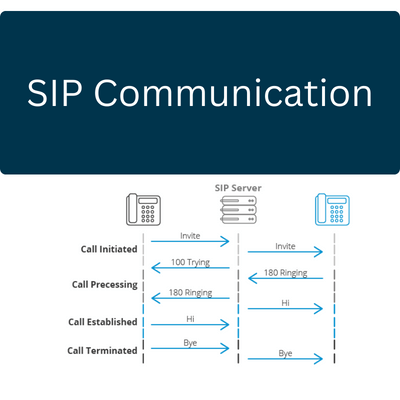List of major protocols categorized according to their respective layers in the network protocol stack:
1. Application Layer:
- HTTP (Hypertext Transfer Protocol)
- SMTP (Simple Mail Transfer Protocol)
- FTP (File Transfer Protocol)
- DNS (Domain Name System)
- SNMP (Simple Network Management Protocol)
- SIP (Session Initiation Protocol)
- DHCP (Dynamic Host Configuration Protocol)
- POP3 (Post Office Protocol version 3)
- IMAP (Internet Message Access Protocol)
- SSH (Secure Shell)
- HTTP (Hypertext Transfer Protocol)
- HTTPS (HTTP Secure)
- FTP (File Transfer Protocol)
- FTPS (FTP Secure)
- TFTP (Trivial File Transfer Protocol)
- SMTP (Simple Mail Transfer Protocol)
- POP3 (Post Office Protocol version 3)
- IMAP (Internet Message Access Protocol)
- DNS (Domain Name System)
- SNMP (Simple Network Management Protocol)
- DHCP (Dynamic Host Configuration Protocol)
- NTP (Network Time Protocol)
- SIP (Session Initiation Protocol)
- RTP (Real-time Transport Protocol)
- RTSP (Real-Time Streaming Protocol)
- LDAP (Lightweight Directory Access Protocol)
- XMPP (Extensible Messaging and Presence Protocol)
- SSH (Secure Shell)
- Telnet
- SNMP (Simple Network Management Protocol)
- RDP (Remote Desktop Protocol)
- SMB (Server Message Block)
- DNS (Domain Name System)
- DHCP (Dynamic Host Configuration Protocol)
- NFS (Network File System)
- AFP (Apple Filing Protocol)
- MQTT (Message Queuing Telemetry Transport)
- CoAP (Constrained Application Protocol)
2. Transport Layer:
- TCP (Transmission Control Protocol)
- UDP (User Datagram Protocol)
- TCP (Transmission Control Protocol)
- UDP (User Datagram Protocol)
- SCTP (Stream Control Transmission Protocol)
- DCCP (Datagram Congestion Control Protocol)
3. Network Layer:
- IP (Internet Protocol)
- ICMP (Internet Control Message Protocol)
- ARP (Address Resolution Protocol)
- OSPF (Open Shortest Path First)
- BGP (Border Gateway Protocol)
- IP (Internet Protocol)
- IPv4 (Internet Protocol version 4)
- IPv6 (Internet Protocol version 6)
- ICMP (Internet Control Message Protocol)
- IGMP (Internet Group Management Protocol)
- ARP (Address Resolution Protocol)
- RIP (Routing Information Protocol)
- OSPF (Open Shortest Path First)
- BGP (Border Gateway Protocol)
- IS-IS (Intermediate System to Intermediate System)
- EIGRP (Enhanced Interior Gateway Routing Protocol)
4. Data Link Layer:
- Ethernet
- PPP (Point-to-Point Protocol)
- HDLC (High-Level Data Link Control)
- Frame Relay
- Wi-Fi (IEEE 802.11 family of protocols)
- Ethernet
- Wi-Fi (IEEE 802.11 family of protocols)
- PPP (Point-to-Point Protocol)
- HDLC (High-Level Data Link Control)
- Frame Relay
- ATM (Asynchronous Transfer Mode)
- MPLS (Multiprotocol Label Switching)
- Token Ring
- FDDI (Fiber Distributed Data Interface)
- SONET (Synchronous Optical Networking)
- SDH (Synchronous Digital Hierarchy)
- DOCSIS (Data Over Cable Service Interface Specification)
5. Physical Layer:
- Ethernet Physical Layer (e.g., 1000BASE-T, 10GBASE-SR)
- DSL (Digital Subscriber Line)
- Fiber Optic (e.g., SONET/SDH)
- Coaxial Cable (e.g., DOCSIS for cable modems)
- Wireless Physical Layer (e.g., Wi-Fi, Bluetooth, LTE)
- Ethernet Physical Layer (e.g., 10BASE-T, 1000BASE-T)
- DSL (Digital Subscriber Line)
- Fiber Optic (e.g., SONET/SDH)
- Coaxial Cable (e.g., DOCSIS for cable modems)
- Wireless Physical Layer (e.g., Wi-Fi, Bluetooth, LTE)
This is not an exhaustive list, as there are numerous protocols in each layer and variations within each protocol. Additionally, some protocols may operate across multiple layers, such as IP which operates at the Network Layer but is encapsulated within Ethernet frames at the Data Link Layer. The list provided includes some of the widely used and well-known protocols in each layer of the network protocol stack.
Which Protocols operate across multiple layers?
List of protocols that operate across multiple layers of the network protocol stack:
1. TCP/IP (Transmission Control Protocol/Internet Protocol):
- TCP operates at the Transport Layer, providing reliable, connection-oriented data delivery.
- IP operates at the Network Layer, responsible for addressing, routing, and fragmenting/reassembling packets.
UDP/IP (User Datagram Protocol/Internet Protocol):
- UDP operates at the Transport Layer, providing connectionless, unreliable data delivery.
- IP operates at the Network Layer, handling addressing, routing, and packet fragmentation/reassembly.
Ethernet:
- Ethernet operates at the Data Link Layer, providing a frame-based mechanism for data transmission.
- It uses MAC (Media Access Control) addresses to identify devices at the Data Link Layer.
IPv6 over Ethernet:
- IPv6 (Internet Protocol version 6) operates at the Network Layer, handling addressing, routing, and packet fragmentation/reassembly.
- Ethernet operates at the Data Link Layer, providing the frame structure and physical transmission.
PPP (Point-to-Point Protocol):
- PPP operates at the Data Link Layer, encapsulating multiple network layer protocols for transmission.
- It is commonly used for establishing point-to-point connections over various physical media, such as serial connections and DSL.
MPLS (Multiprotocol Label Switching):
- MPLS operates across the Data Link Layer and Network Layer, using labels to forward packets within a network.
- It is often used to provide traffic engineering, quality of service (QoS), and virtual private network (VPN) services.
DNS (Domain Name System):
- DNS operates across the Application Layer, Transport Layer (using TCP or UDP), and Network Layer (using IP).
- It resolves domain names to IP addresses, enabling the translation between human-readable domain names and machine-readable IP addresses.
TLS/SSL (Transport Layer Security/Secure Sockets Layer):
- TLS/SSL operates between the Transport Layer and the Application Layer, providing secure communication channels.
- It encrypts data and provides authentication and integrity checks for secure transmission over protocols like HTTP (HTTPS).
These are some examples of protocols that span multiple layers, providing functionality and services across those layers in the network protocol stack.






